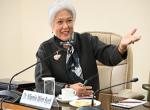A meeting to discuss the implications of the Chinese intrusion in Ladakh was held at the VIF on 26 April 2013. Gen NC Vij, former COAS briefed a select group of former diplomats and Army officers on the issue. Among those present included Mr Ajit Doval, KC, Director VIF, Ambassador Kanwal Sibal, Ambassador Rajiv Sikri, Lt Gen RK Sawhney (Retd), Brig Vinod Anand (Retd) and Brig Gurmeet Kanwal (Retd). Gen Vij began by situating the location of the intrusion and terrain configuration of the general area. The area lies between the Karakoram and the Ladakh Ranges and is towards the south-east of the Saltoro Ridge. The Karakoram Highway runs northward across the Karakoram Pass but the going is tough due to glaciated terrain and it is not physically possible to interdict the highway. While explaining the dynamics of the Line of Actual Control (LAC) environment, he said that such transgressions were a common occurrence by both sides but the difference this time is the fact that the Chinese patrol decided to stay put on the Indian side.
Chinese troops in platoon strength have pitched tents in a patch of land south-east of Daulat Beg Oldie in Sub-sector North. Indian troops have also positioned themselves facing the Chinese. Tactically, the Chinese occupation is of little significance and can be easily isolated by establishing blocking positions and cutting off their supply line. Gen Vij also outlined other available military options including carrying out similar incursions on Chinese side of the LAC in a different sector and then use the same as a bargaining counter. He also reiterated the need for having unity of command along the LAC and placing the Indo-Tibetan Border Police (ITBP) under the Army’s chain of command for effective border management.
China’s action is at variance with the general improvement of India-China ties, notably in the economic domain but also in terms of maintaining high level political exchanges bilaterally and working together in multilateral groupings. Defence contacts and regional dialogues, including the recent one on Afghanistan, are other signs of positive engagement between the two countries. This incident comes in the wake of the supposedly friendly exchanges between our Prime Minister and President XI Jinping at Durban on the occasion of the BRICS Summit. The Chinese action also appears to have the blessings of higher authorities and was not merely carried out by a local commander on the ground. The discussion was centred on understanding Chinese motivations behind the intrusion. Some felt that China was giving a strong message to India ahead of Prime Minister’s Le Keqiang’s scheduled visit to India on 21 May. Another reason could be that the Chinese have decided to pressure India in order to dissuade it from participating in the US pivot towards Asia, about which they are deeply concerned. However, the logic seems to be unsound as this move may well push India closer to the US.
It was felt that India should have been more firm in dealing with the situation and must not accede to Chinese demands of suspending infrastructure development works on our side of the LAC. Under the circumstances, the scheduled visit of Foreign Minister Salman Khurshid to China is undesirable and India should have insisted that the Chinese first vacate their intrusion. In the long run, India should form closer alliances with the Rim Land countries in East Asia to counter Chinese aggressiveness and be prepared to meet any eventuality on the ground. India needs to give out a strong message to China that its bullying tactics and bellicosity would not be accepted. At the same time, the political and military leadership should draw important lessons from this episode and have a contingency in place for similar occurrences in the foreseeable future.








